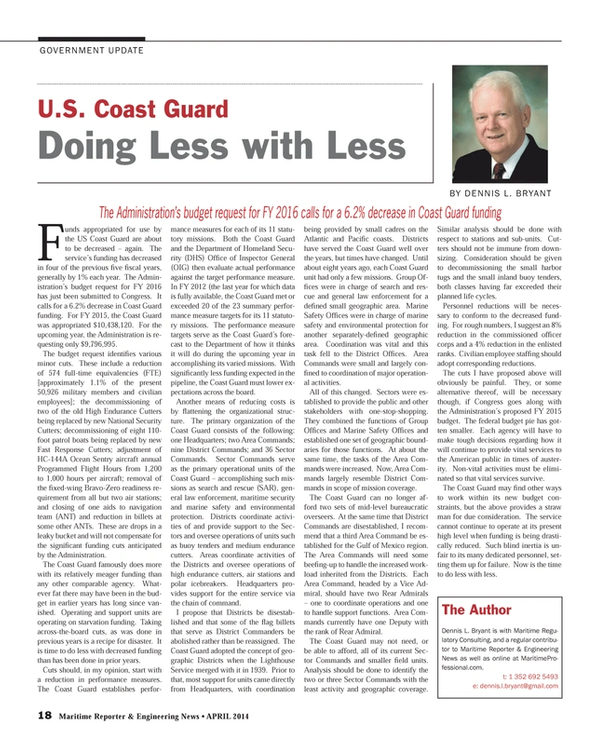
U.S. Coast Guard Doing Less with Less
The Administration’s budget request for FY 2016 calls for a 6.2% decrease in Coast Guard funding
Funds appropriated for use by the US Coast Guard are about to be decreased – again. The service’s funding has decreased in four of the previous five fiscal years, generally by 1% each year. The Administration’s budget request for FY 2016 has just been submitted to Congress. It calls for a 6.2% decrease in Coast Guard funding. For FY 2015, the Coast Guard was appropriated $10,438,120. For the upcoming year, the Administration is requesting only $9,796,995.
The budget request identifies various minor cuts. These include a reduction of 574 full-time equivalencies (FTE) [approximately 1.1% of the present 50,926 military members and civilian employees]; the decommissioning of two of the old High Endurance Cutters being replaced by new National Security Cutters; decommissioning of eight 110-foot patrol boats being replaced by new Fast Response Cutters; adjustment of HC-144A Ocean Sentry aircraft annual Programmed Flight Hours from 1,200 to 1,000 hours per aircraft; removal of the fixed-wing Bravo-Zero readiness requirement from all but two air stations; and closing of one aids to navigation team (ANT) and reduction in billets at some other ANTs. These are drops in a leaky bucket and will not compensate for the significant funding cuts anticipated by the Administration.
The Coast Guard famously does more with its relatively meager funding than any other comparable agency. Whatever fat there may have been in the budget in earlier years has long since vanished. Operating and support units are operating on starvation funding. Taking across-the-board cuts, as was done in previous years is a recipe for disaster. It is time to do less with decreased funding than has been done in prior years.
Cuts should, in my opinion, start with a reduction in performance measures. The Coast Guard establishes performance measures for each of its 11 statutory missions. Both the Coast Guard and the Department of Homeland Security (DHS) Office of Inspector General (OIG) then evaluate actual performance against the target performance measure. In FY 2012 (the last year for which data is fully available, the Coast Guard met or exceeded 20 of the 23 summary performance measure targets for its 11 statutory missions. The performance measure targets serve as the Coast Guard’s forecast to the Department of how it thinks it will do during the upcoming year in accomplishing its varied missions. With significantly less funding expected in the pipeline, the Coast Guard must lower expectations across the board.
Another means of reducing costs is by flattening the organizational structure. The primary organization of the Coast Guard consists of the following: one Headquarters; two Area Commands; nine District Commands; and 36 Sector Commands. Sector Commands serve as the primary operational units of the Coast Guard – accomplishing such missions as search and rescue (SAR), general law enforcement, maritime security and marine safety and environmental protection. Districts coordinate activities of and provide support to the Sectors and oversee operations of units such as buoy tenders and medium endurance cutters. Areas coordinate activities of the Districts and oversee operations of high endurance cutters, air stations and polar icebreakers. Headquarters provides support for the entire service via the chain of command.
I propose that Districts be disestablished and that some of the flag billets that serve as District Commanders be abolished rather than be reassigned. The Coast Guard adopted the concept of geographic Districts when the Lighthouse Service merged with it in 1939. Prior to that, most support for units came directly from Headquarters, with coordination being provided by small cadres on the Atlantic and Pacific coasts. Districts have served the Coast Guard well over the years, but times have changed. Until about eight years ago, each Coast Guard unit had only a few missions. Group Offices were in charge of search and rescue and general law enforcement for a defined small geographic area. Marine Safety Offices were in charge of marine safety and environmental protection for another separately-defined geographic area. Coordination was vital and this task fell to the District Offices. Area Commands were small and largely confined to coordination of major operational activities.
All of this changed. Sectors were established to provide the public and other stakeholders with one-stop-shopping. They combined the functions of Group Offices and Marine Safety Offices and established one set of geographic boundaries for those functions. At about the same time, the tasks of the Area Commands were increased. Now, Area Commands largely resemble District Commands in scope of mission coverage.
The Coast Guard can no longer afford two sets of mid-level bureaucratic overseers. At the same time that District Commands are disestablished, I recommend that a third Area Command be established for the Gulf of Mexico region. The Area Commands will need some beefing-up to handle the increased workload inherited from the Districts. Each Area Command, headed by a Vice Admiral, should have two Rear Admirals – one to coordinate operations and one to handle support functions. Area Commands currently have one Deputy with the rank of Rear Admiral.
The Coast Guard may not need, or be able to afford, all of its current Sector Commands and smaller field units. Analysis should be done to identify the two or three Sector Commands with the least activity and geographic coverage. Similar analysis should be done with respect to stations and sub-units. Cutters should not be immune from downsizing. Consideration should be given to decommissioning the small harbor tugs and the small inland buoy tenders, both classes having far exceeded their planned life cycles.
Personnel reductions will be necessary to conform to the decreased funding. For rough numbers, I suggest an 8% reduction in the commissioned officer corps and a 4% reduction in the enlisted ranks. Civilian employee staffing should adopt corresponding reductions.
The cuts I have proposed above will obviously be painful. They, or some alternative thereof, will be necessary though, if Congress goes along with the Administration’s proposed FY 2015 budget. The federal budget pie has gotten smaller. Each agency will have to make tough decisions regarding how it will continue to provide vital services to the American public in times of austerity. Non-vital activities must be eliminated so that vital services survive.
The Coast Guard may find other ways to work within its new budget constraints, but the above provides a straw man for due consideration. The service cannot continue to operate at its present high level when funding is being drastically reduced. Such blind inertia is unfair to its many dedicated personnel, setting them up for failure. Now is the time to do less with less.
The Author
Dennis L. Bryant is with Maritime Regulatory Consulting, and a regular contributor to Maritime Reporter & Engineering News as well as online at MaritimeProfessional.com.
t: 1 352 692 5493
e: [email protected]
(As published in the April 2014 edition of Maritime Reporter & Engineering News - http://magazines.marinelink.com/Magazines/MaritimeReporter)
Read U.S. Coast Guard Doing Less with Less in Pdf, Flash or Html5 edition of April 2014 Maritime Reporter
Other stories from April 2014 issue
Content
- Offshore: Seacor Raises the Bar Again page: 13
- Offshore Service Vessels Design Innovation page: 14
- U.S. Coast Guard Doing Less with Less page: 18
- New Conept Under Test: Arctic Drillship page: 20
- If You Have DPS Questions ... OSVDPA Has Answers page: 22
- How to Work with Your Insurer When Experiencing a Loss page: 24
- Calculating Settlement Value of a Case page: 26
- Strategic Planning With Aggregate Data page: 30
- Is Internal Combustion Engine Methane Slip Harmful to the Environment? page: 32
- Floating Production Growth May Face Obstacles page: 38
- Arctic Energy Exploration Efforts Heat Up page: 44
- Saipem: A Fleet Grows in Brazil page: 50
- Inside Paraguay’s Oil Boom page: 54
- The History of Offshore Energy page: 56
- Offshore Energy Timeline:1806-2014 page: 56
- C-MAR's Modern Approach to DP Training in Brazil page: 64
- CNR: Innovation Maintains US Naval Advantages page: 66
- STEM: SeaPerch Underwater Robotic Championships page: 72
- Safety the Focus as Heavy Lifting Picks Up page: 78
- Cool Runnings: R.W. Fernstrum's Engineered Solutions page: 82
- Rosie the Riveter: WWII Women Shipyard Workers Visit the White House page: 88
- Modern Solutions Power Systems Conference page: 91
- ABS Approves Design for GTTNA’s LNG Bunker Barge page: 92
- Rolls-Royce Wins Heyerdahl Award page: 94
- Damen Opens JV Yard in Vietnam page: 95
- BASS Launches New Fleet Management System page: 96
- Shipboard Pipe-joining Techniques Examined page: 98
- Luxury Yachts: Design Takes a New Track page: 100
- New Air Regulator from TDI page: 103
- DNV GL ShipManager for Entire H&P Fleet page: 103
- FARO Debuts X Series Laser Scanner page: 103
- Jinglu Chooses AVEVA Design Software page: 103
- Macro Sensors Gauge Tank Volume Changes page: 103
- Special Coupling Solution for Offshore Drives page: 103
- Conquest Offshore Buys Star Software page: 103
- Eniram Launches New Optimization Product for LNG Sector page: 104
- COSCO Selects Rolls-Royce Package page: 104
- New Tests for Ballast Water Contamination page: 104
- SSI Debuts Updated ShipConstructor page: 104
- Wärtsilä’s Launches Inline Scrubber System page: 104
- New Transas Liquid Cargo Handling Simulator page: 104
- New Hull Structure Analysis Software page: 104
- GEA Westfalia Separator Launches New Control Generation page: 105
- Omega Debuts Compact RTD Temperature Sensors page: 105
- New Heavy Duty CNC Plasma System page: 105
- Wärtsilä Introduces 46DF Dual Fuel Engine page: 105
- WSS Achieves Better Onboard Air Quality page: 105
- Trojan Marinex BWT System Earns IMO Type Approval page: 106


